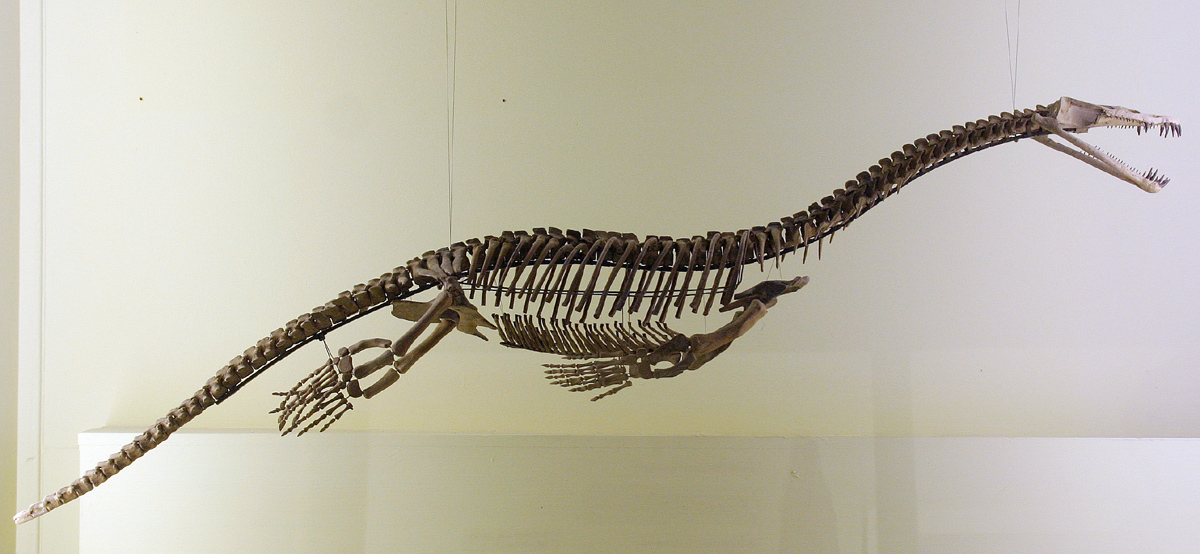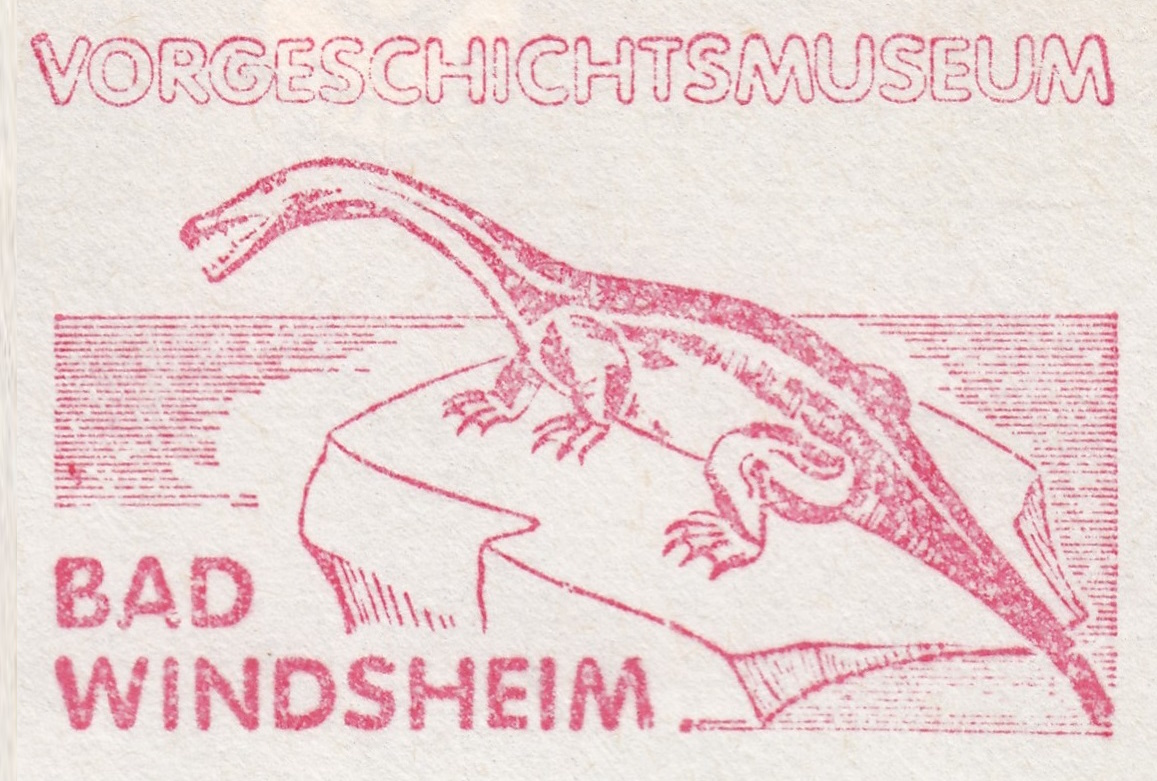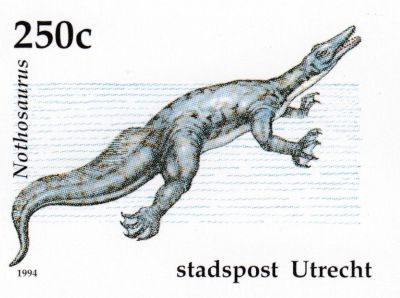Netherlands 2023 "Prehistoric animals (II)"
| <prev | back to index | next> |
| Issue Date | 26.09.2023 |
| ID | Michel: N/A, Scott: N/A, Stanley Gibbons: N/A, Yvert et Tellier: N/A, Category: pR |
| Design | stamps: studio026, Velp animal models: ManimalWorks, Rotterdam |
| Stamps in set | 15 |
| Values |
3 Mini-Sheets of 5 stamps each, with face value "1",
each Mini-Sheet contain 3 stamps with reconstruction
and 2 stamps with fossils of the prehistoric animal: Nothosaurus Woolly Rhinoceros, Coelodonta antiquitatis Aurochs, Bos primigenius Value indicates 1 for mail up to and including 20g to a destination within the Netherlands. |
| Size (width x height) | stamps: 30mm x40mm Mini-Sheet: 170mm x 122mm |
| Layout | 3 Mini-Sheets of 5 stamps each |
| Products | None |
| Paper | normal with phosphorus pressure |
| Perforation | |
| Print Technique | Offset, 3 colors: cyan, magenta, yellow and black |
| Printed by | |
| Quantity | 5,000 of each Mini-Sheet |
| Issuing Authority | PostNL |
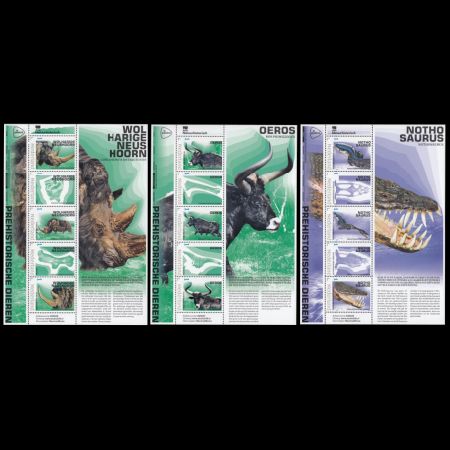
On September 26th, 2023, the Post Authority of the Netherlands, PostNL, issued the second 3 of 12 Mini-Sheets with personal stamps showing "Prehistoric Animals".
Personal stamps are stamps proposed by individuals or organizations, accepted, printed, and sold by PostNL.
The first 3 Mini-Sheets were issued on June 13th, 2023. Detailed descriptions of the first issue as well as details about the design team for the entire series of mini-sheets, can be found here.The denomination on these stamps is "1", the rate for items weighing up to 20g with destinations in the Netherlands and has a value of €1,01 at the time of issue. Each stamp sheet in the "Prehistoric Animals" series includes five personal stamps in five different designs. Three stamps feature various images of the reconstructions of the prehistoric animals in their natural habitats. The other two stamps feature fossils of the same animal, surrounded by stylized earth layers in which that fossil was found.
Fossils of all prehistoric animals depicted on the stamps were found on the seabed of the southern North Sea.
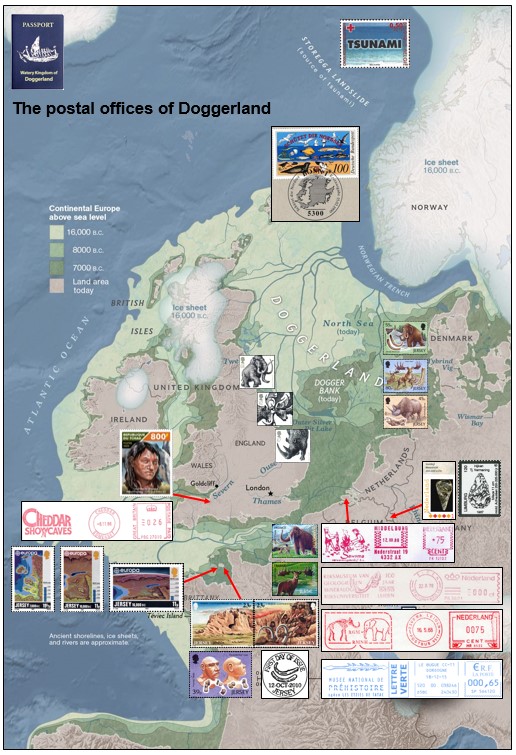
|
| Map of Doggerland with associated philatelic materials. Image credit: the image was created by fellow collector Mr Peter Brandhuber from Germany. |
In addition, over the past three decades, several expeditions have been implemented using chartered beam trawlers with the aim of intensively dredging for fossil land mammals from the Pleistocene sediments at locations that had previously yielded chance finds from commercial beam trawling.
With modern accurate positioning, the location of the finds can be properly mapped out. This collaboration between the crews of those beam trawlers that brought the bycatch ashore, and the active, very interested collectors, has yielded a wealth of scientific information about the life in what is referred to as Doggerland.
The fossils indicate that during the Pleistocene and the beginning of the Holocene there were land connections between the continent of Europe and the British Isles.
Doggerland was an area of land in Northern Europe, now submerged
beneath the North Sea, that connected Britain to continental Europe.
It was flooded by rising sea levels around 6500–6200 BCE.
The flooded land is known as the Dogger Littoral.
Geological surveys have suggested that it stretched from what is now the east coast
of Great Britain to what is now the Netherlands,
the western coast of Germany and the Danish
peninsula of Jutland.
It was probably a rich habitat with human habitation in the Mesolithic period,
although rising sea levels gradually reduced it to low-lying islands before its final submergence,
possibly following a tsunami caused by the Storegga Slide in Norway.
Doggerland was named after the Dogger Bank, which in turn was named after 17th-century Dutch
fishing boats called doggers.
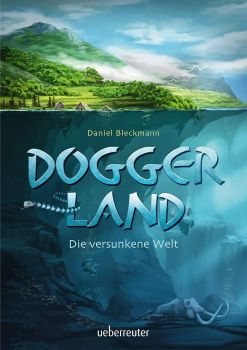 |
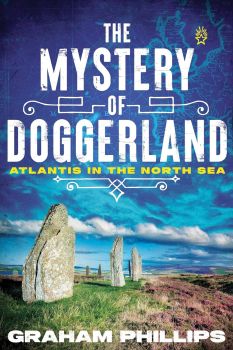 |
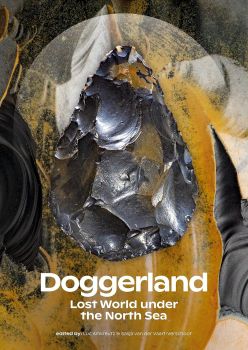 |
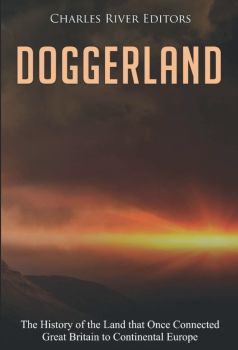 |
|
"Doggerland: Die versunkene Welt", by Daniel Bleckmann (in German), Published in 2020. Amazon: USA, UK, DE |
"The Mystery of Doggerland: Atlantis in the North Sea", by Graham Phillips, Published in 2023. Amazon: USA, UK, DE |
"Doggerland. Lost World under the North Sea", by Luc Amkreutz, Published in 2022. Amazon: USA, UK, DE |
"Doggerland: The History of the Land that Once Connected Great Britain to Continental Europe", by Charles River Editors, Published in 2021. Amazon: USA, UK, DE |
The geological surveys of the countries surrounding the North Sea have mapped the deposits which make up the seabed. Based on the geological history, a better insight was gained into the influence of the cold times (ice ages) in which the sea level was up to 125 m lower than today and the finds of people and animals that lived on the dry seabed can be better understood, and be placed in time.
The accumulation of knowledge on these fossil localities is the result of intense collaboration between museums, private collectors and the fishing industry. It all began when the curator of mammalian fossils of the former Rijksmuseum van Geologie en Mineralogie (Dutch National Museum for Geology and Mineralogy, nowadays incorporated into Naturalis Biodiversity Center (Leiden)), Mr. G. Kortenbout van der Sluijs, began visiting Dutch fishing ports in the 1960s to obtain fossil bones for his museum. He found that the larger beam trawlers of over 40-44 m in length, which fished for flatfish outside the 12-mile zone, were particularly successful in collecting fossil mammal evidence with their haul of fish.
An extensive collection of large skeletal parts of woolly mammoths, woolly rhinos and steppe wisents (Bisons) from the Late Pleistocene, that were fished from the seafloor of the coast of the province of Zeeland in the 19th century, were kept by the Koninklijk Zeeuwsch Genootschap der Wetenschappen in Middelburg.
Two of the animals were depicted on the stamps below.
Woolly Rhinoceros, Coelodonta antiquitatis


|
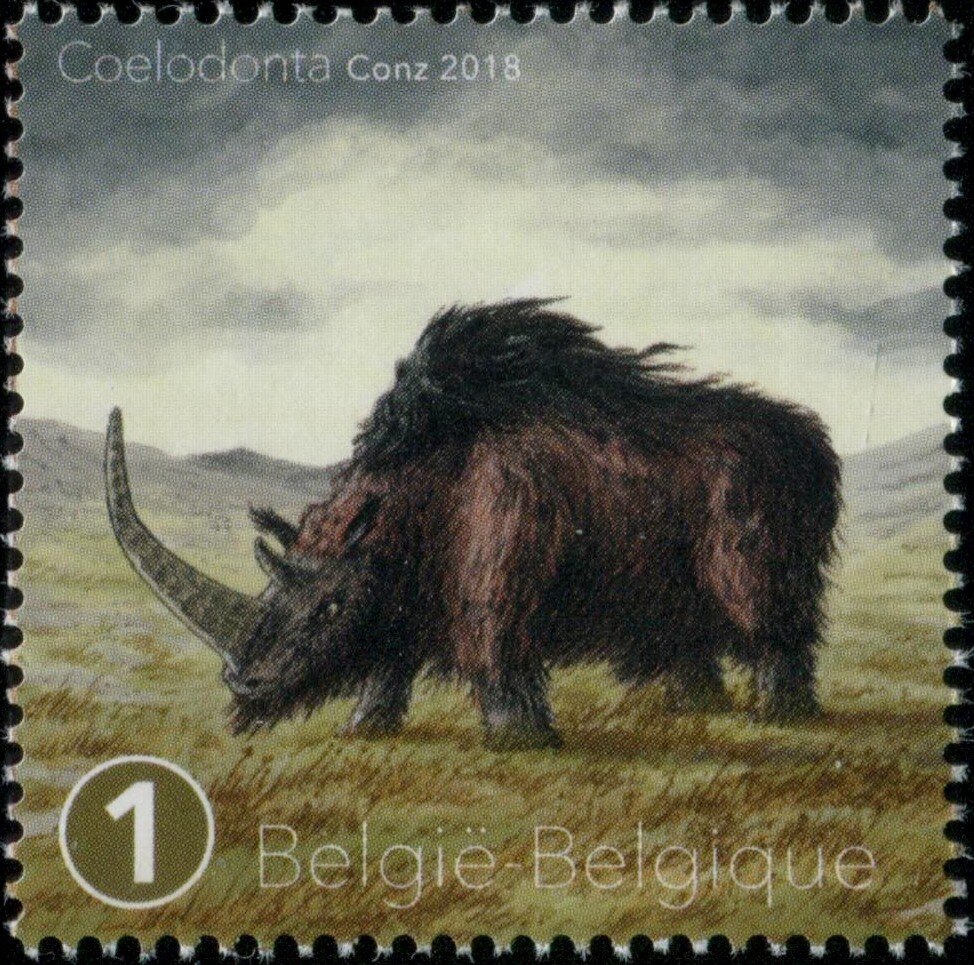
|
| Woolly Rhinoceros on stamp of Belgium 2018 |
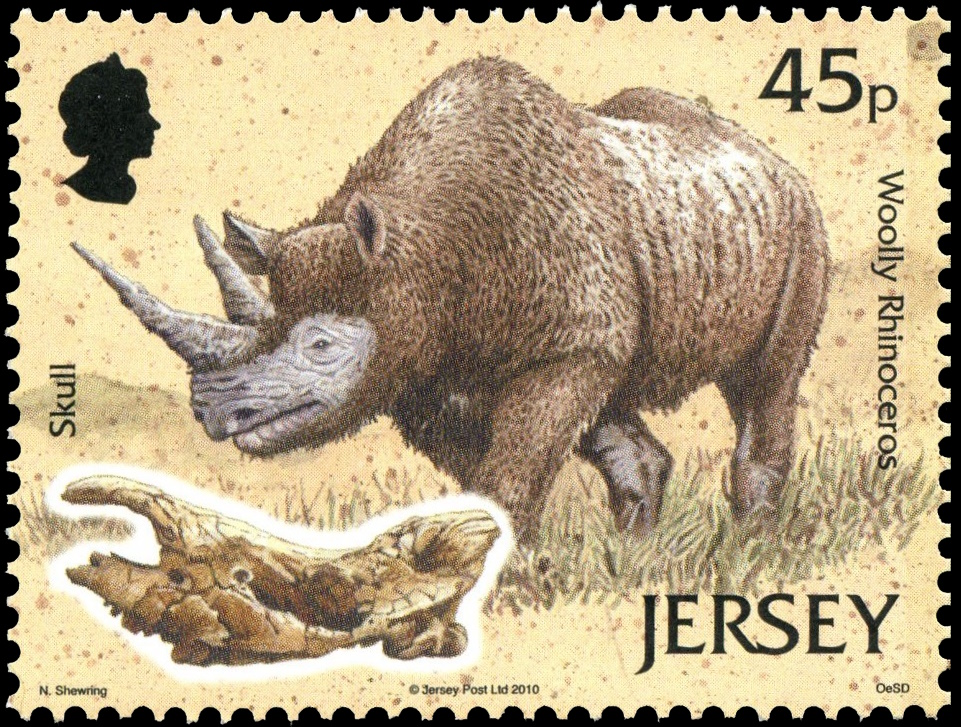
|
| Woolly Rhinoceros on stamp of Jersey 2010 |
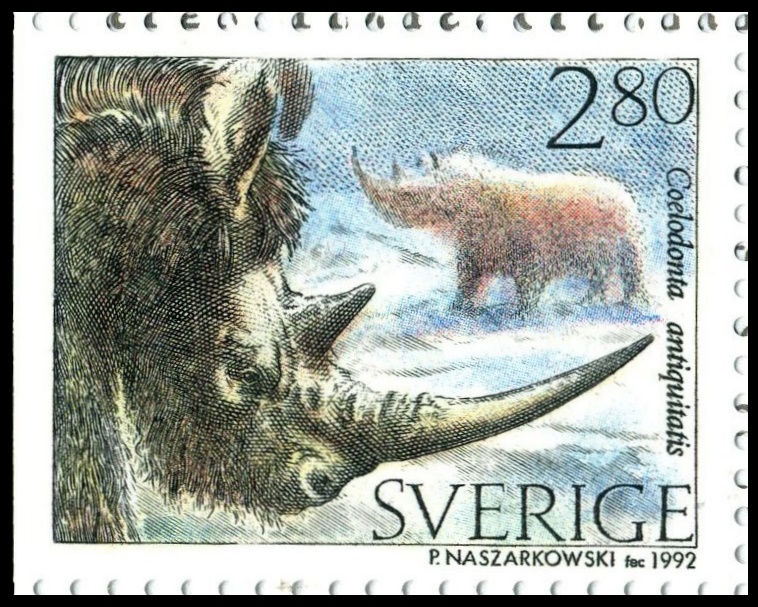
|
| Woolly Rhinoceros on stamp of Sweden 1992 |
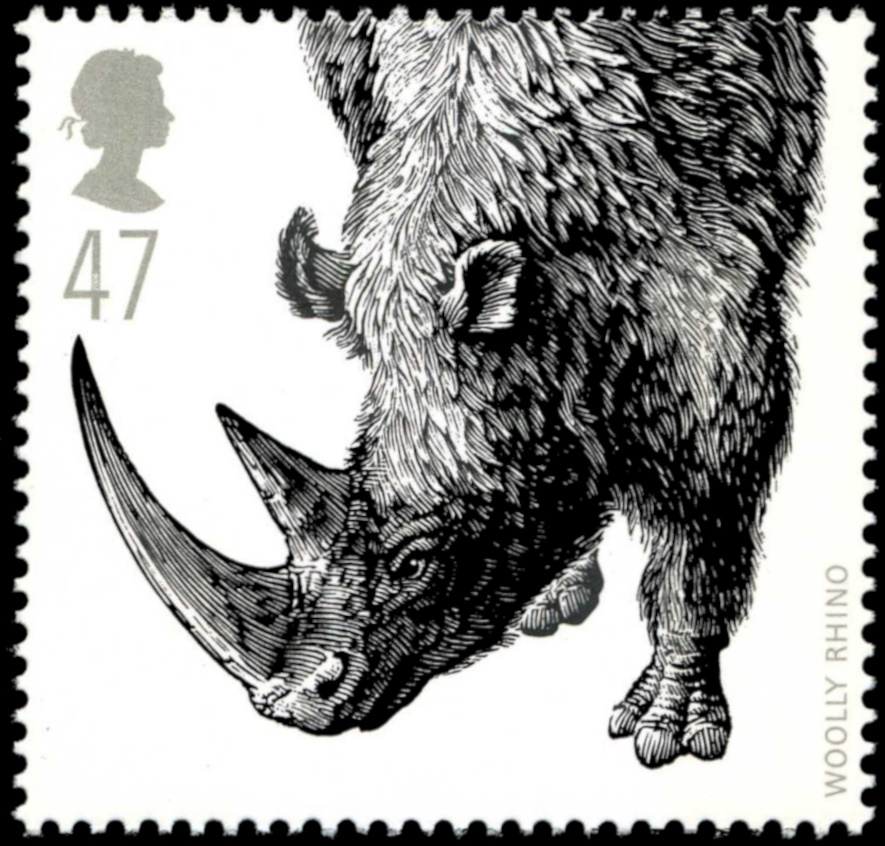
|
| Woolly Rhinoceros on stamp of UK 2006 |
DNA evidence suggests that the Sumatran Rhinoceros (Dicerorhinus sumatrensis) is the closest living relative of Coelodonta.
The woolly rhinoceros, Coelodonta antiquitatis, is well represented in all sites of fossil mammals of the North Sea floor. All the ontogenetic stages of this large grazer are well known. Complete skulls have also been by-caught over time, including at various locations of the coast of Zeeland (in the collection of the Koninklijk Zeeuwsch Genootschap der Wetenschappen) and the Eurogeul area in the vicinity of the Maas Center buoy (Kommer Tanis collection, Haven- hoofd, Goeree-Overflakkee).
This rhinoceros, a companion of the woolly mammoth, must have been a common species on the mammoth steppe of Doggerland in the Late Pleistocene. The skeletal remains of the woolly rhinoceros are clearly distinguishable from the other species of rhinos that we know from the North Sea floor. The molars are high-crowned, the enamel is strongly ribbed and the chewing surface is very complex and advanced, extremely suitable for devouring tough food, such as the grasses of the mammoth steppe. Their skeletal parts are relatively heavy and stocky in build, very different from the browsing rhinos such as the Etruscan, Stephanorhinus etruscus, and the forest rhinoceros, Stephanorhinus kirchbergensis, from the Early and Late Pleistocene (Eemian), respectively.
The woolly rhinoceros was widespread in the Late Pleistocene, from the westernmost part of Doggerland to the northeast of the Eurasian continent. Coelodonta antiquitatis never crossed the so-called Bering land bridge to the North American continent. Perhaps that environment was too wet. Possibly we could conclude from this that the extensive mammoth steppe of Late Pleistocene Doggerland, where the Southern Bight of the North Sea is now located, had been very dry.
An adult woolly rhinoceros typically measured 3.2 to 3.6 metres from head to tail, stood 1.45–1.6 metres tall at the shoulder and weighed up to 1.5–2 tons. Both males and females had two horns which were made of keratin, with one long horn reaching forward and a smaller horn between the eyes. The front horn would have measured 1–1.35 metres long for individuals at 25 to 35 years of age, while the second horn would have measured up to 47.5 centimetres long. Compared to other rhinoceroses, the woolly rhinoceros had a longer head and body, and shorter legs. Its shoulder was raised with a powerful hump, used to support the animal's massive front horn. The hump also contained a fat reserve to aid survival through the desolate winters of the mammoth steppe.
The woolly rhinoceros was covered with long, thick hair that allowed it to survive in the extremely cold, harsh mammoth steppe. It had a massive hump reaching from its shoulder and fed mainly on herbaceous plants that grew in the steppe. Mummified carcasses preserved in permafrost and many bone remains of woolly rhinoceroses have been found. Images of woolly rhinoceroses are found among cave paintings in Europe and Asia. The species range contracted towards Siberia beginning around 17,000 years ago, with the youngest known records being around 14,000 years old in northeast Siberia, coinciding with the Bølling–Allerød warming, which likely disrupted its habitat.
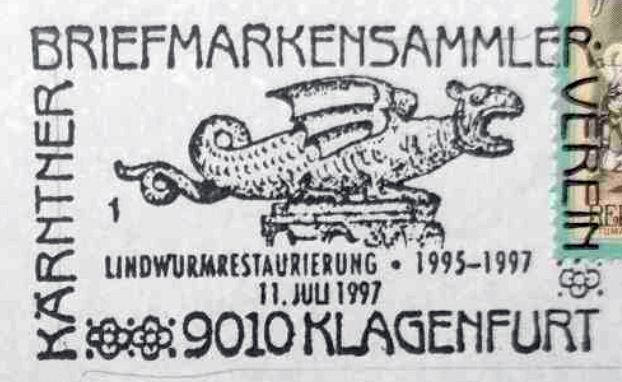 |
| The statue of a lindwurm from Klagenfurt on postmark of Austria, 1997 |
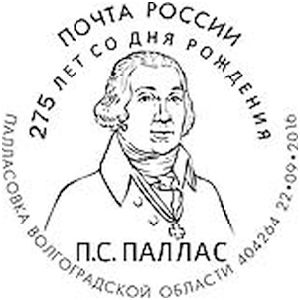 |
| Peter Simon Pallas on commemorative postmark of Russia 2016 |
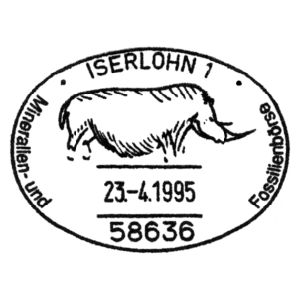 |
| Woolly rhinoceros on commemorative postmark of Germany 1995 |
A rhinoceros skull was found in Klagenfurt, Austria, in 1335, and was believed to be that of a dragon.
Legend has it that Klagenfurt was founded after a couple of brave men had slain the abominable "Lindwurm", a winged dragon in the moors adjoining the lake, the staple diet of which is said to have been virgins, but which did not spurn the fat bull on a chain that the men had mounted on a strong tower.
In 1590, it was used as the basis for the head on a statue of a lindwurm.Gotthilf Heinrich von Schubert maintained the belief that the horns were the claws of giant birds, and classified the animal under the name Gryphus antiquitatis, meaning "griffin of antiquity".
This skull is still on exhibit at the Landesmuseum für Kärnten.
One of the earliest scientific descriptions of an ancient rhinoceros species was made in 1769, when the naturalist Peter Simon Pallas wrote a report on his expeditions to Siberia where he found a skull and two horns in the permafrost. In 1772, Pallas acquired a head and two legs of a rhinoceros from the locals in Irkutsk, and named the species Rhinoceros lenenesis (after the Lena River). In 1799, Johann Friedrich Blumenbach studied rhinoceros bones from the collection of the University of Göttingen, and proposed the scientific name Rhinoceros antiquitatis. The geologist Heinrich Georg Bronn moved the species to Coelodonta in 1831 because of its differences in dental formation with members of the Rhinoceros genus.
The image on the stamp is based on a life size reconstruction made by Remie Bakker, a paleo-artist from Rotterdam for the Museum Twentse Wellen in the Netherlands in 2007. The fur color of the model was based on some cave paintings from France and was made under the supervision of Mr. Dick Mol.
Another life size model of mother and calf Coelodonta antiquitatis was created in 2015 for the travelling Ice Age exhibition made by the Reiss-Engelhorn-Stiftung in Mannheim (Germany).
On his website Mr. Bakker explain the reconstruction process:
To get a better idea for the hair coat of this animal I used cave
paintings as an example.
I feel that the people that made these paintings were seeing these animals in their
daily life and have used these images in the caves.
This is as true a image as we can get from these animals.
If you analyse the drawings of the rhinos you can divide the drawings, roughly,
in two types.
The first has hair hanging from the belly and head and no markings on the body.
The second has no hair hanging down and distinct lighter and darker areas on the head
and body.
The darker places are; the mid body, the sideburns, ears, feet and shoulders.
My conclusion is that the woolly rhino had a summer coat that was marked by lighter
and darker areas.
The winter coat was longer and more uniform in color.
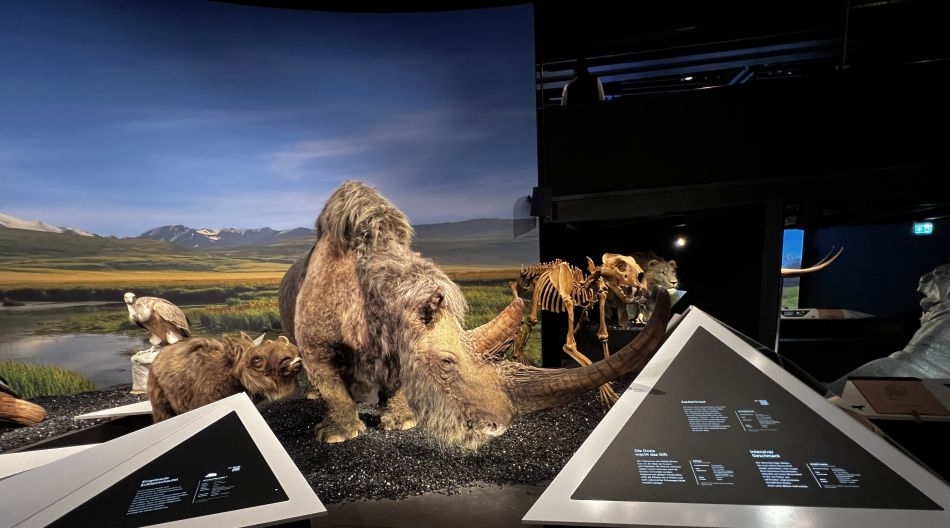
Aurochs, Bos primigenius


|
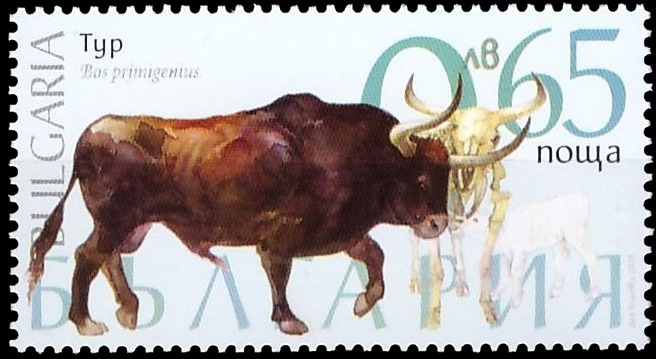
|
| Aurochs on stamp of Bulgaria 2018 |
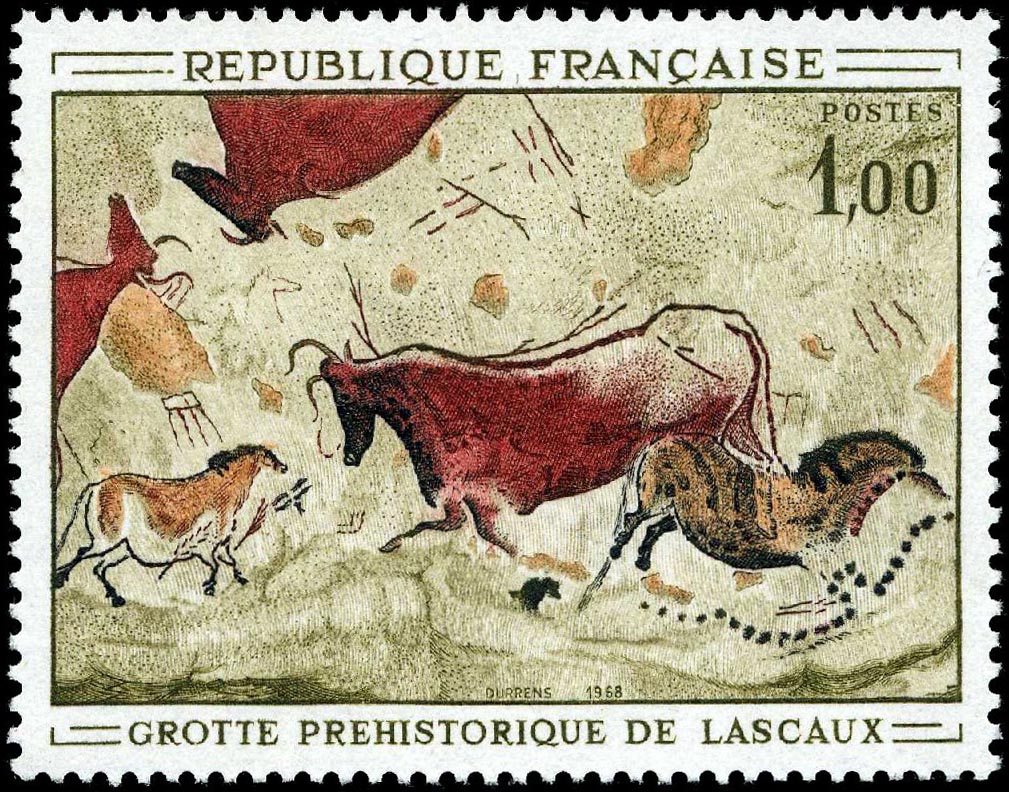
|
| Aurochs on cave painting on stamp of France 1968 |
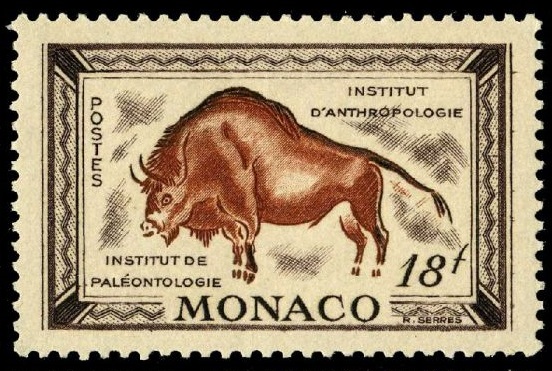
|
| Aurochs on cave painting on stamp of Monaco 1949 |
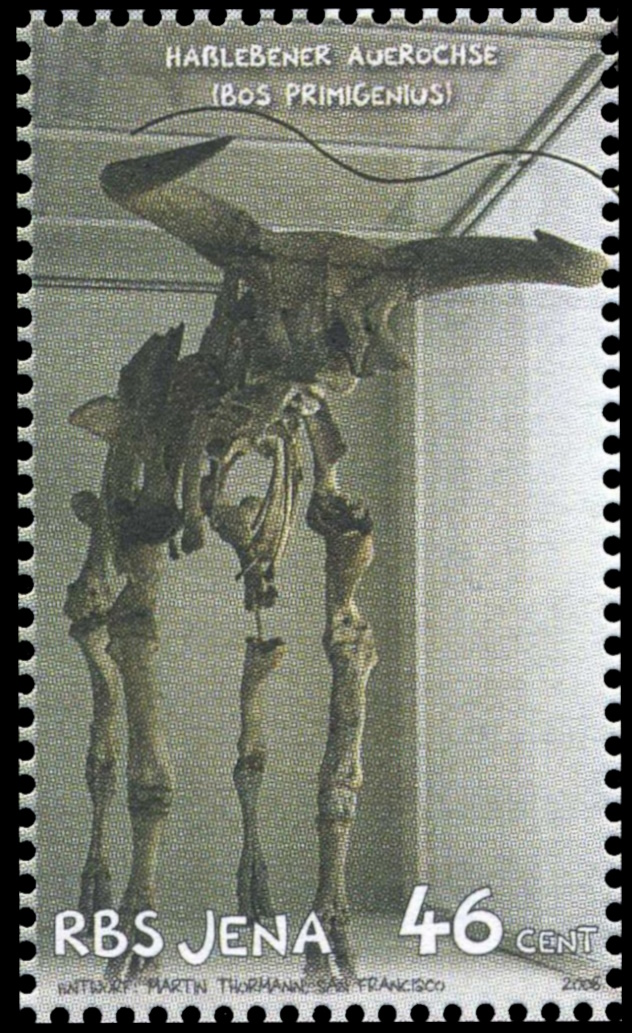
|
| Skeleton of Aurochs on personalized stamp of Germany 2008 |
The aurochs was part of the Pleistocene megafauna. It probably evolved in Asia and migrated west and north during warm interglacial periods. The oldest known aurochs fossils found in India and North Africa date to the Middle Pleistocene and in Europe to the Holstein interglacial. As indicated by fossil remains in Northern Europe, it reached Denmark and southern Sweden during the Holocene. The aurochs declined during the late Holocene due to habitat loss and hunting. The aurochs survived in central Poland until 1627.
The aurochs is recently extinct and not technically a prehistoric animal.
The aurochs is depicted in Paleolithic cave paintings, Neolithic petroglyphs, Ancient Egyptian reliefs and Bronze Age figurines. It symbolised power, sexual potency, and prowess in religions of the ancient Near East. Its horns were used in votive offerings, as trophies and drinking horns.
Two aurochs domestication events occurred during the Neolithic Revolution.
One gave rise to the domestic cattle (Bos taurus) in the Fertile Crescent in the Near East that was introduced to Europe via the Balkans and the coast of the Mediterranean Sea. Hybridisation between aurochs and early domestic cattle occurred during the early Holocene. Domestication of the Indian aurochs led to the zebu cattle (Bos indicus) that hybridised with early taurine cattle in the Near East about 4,000 years ago. Some modern cattle breeds exhibit features reminiscent of the aurochs, such as the dark colour and light stripe along the back of bulls, the lighter colour of cows, or an aurochs-like horn shape.
Remains of large bovids are known in very large quantities from the North Sea. The vast majority is attributed to the Late Pleistocene steppe bison, Bison priscus. The ones attributed to the aurochs, Bos primigenius, are very rare. Almost all the remains of Bos primigenius from the North Sea that we know of can be dated in the Early Holocene.
The few remains of various North Sea sites that are attributed to large bovids such as Bos primigenius can be dated in the Eemian on the basis of a higher degree of fossilization. In the Eemian, this large bovid with heavily built horns and a shoulder height of well over two meters was part of a mammal association that had lived in and near wooded areas. Bos primigenius certainly did not occur as massively in the Late Pleistocene as the almost as large steppe bison.
The image in the stamp is based on the reconstruction made by Remie Bakker, a paleo-artist, in Rotterdam under the supervision of Mr. Dick Mol. The life size model of the Aurochs was created in 2015 for the travelling Ice Age exhibition made by the Reiss-Engelhorn-Stiftung in Mannheim (Germany).
On his website Mr. Bakker explain the reconstruction process:
We know something about this animal because there are found frozen carcasses found
in the US and in Russia.
The rest I have estimated of cave paintings from France and Spain.
I took paintings from several caves and used the most characteristics colour and hair-masses
that they had in common. For the body under the fur I used the modern-day Guar
(Bos gaurus) as an example.
I have the idea that these animals resemble the Bos primigenius the best in
musculature and appearance.
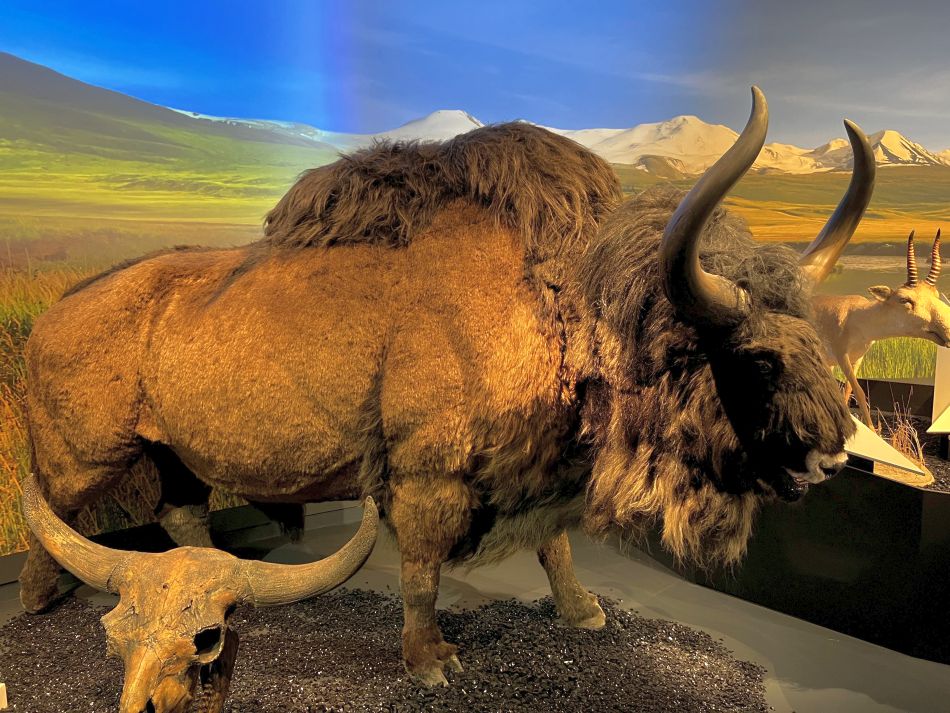
Nothosaurus


|
Sauropterygia ("lizard flippers") is an extinct taxon of diverse, aquatic reptiles that developed from terrestrial ancestors, distantly related to lizards and snakes, soon after the end-Permian extinction and flourished during the Triassic before all except for the Plesiosauria became extinct at the end of that period.
Nothosaurus was a semi-oceanic animal which probably had a lifestyle similar to that of today's seals: it hunted exclusively in water but intermittently came ashore to bask in the sun. It was about 4 metres long, with long, webbed toes and possibly a fin on its tail. When swimming, Nothosaurus would use its tail, legs, and webbed feet to propel and steer it through the water. The skull was broad and flat, with long jaws, lined with needle teeth, it probably caught fish and other marine creatures.
In many respects its body structure resembled that of the much later plesiosaurs, but it was not as well adapted to an aquatic environment. It is thought that one branch of the nothosaurs may have evolved into pliosaurs such as Liopleurodon, a short-necked plesiosaur that grew up to 6.4 in length.
Fossils of Nothosaurus are distributed from North Africa and Europe to China and it is the best known member of the Nothosaur order.
The first time a nearly complete skeleton of Nothosaurus (the head was missing) was discovered in in the rock formation Muschelkalk, at Bayreuth (Bavaria, South of Germany) in 1833. It was the first discovery of a fossilized skeleton of prehistoric reptile on mainland Europe. In 1834 it was described by German paleontologist Christian Erich Hermann von Meyer. In the following years many fossils were discovered in other German towns such as Osnabruck and Hohenlohe.
There are nearly a dozen known species of Nothosaurus, including several species that have been described from the Lower Muschelkalk in Winterswijk, The Netherlands: Nothosaurus marchicus, Nothosaurus winkelhorsti, Nothosaurus winterswijkensis.
Dr. D.A. Hooyer from the National Natural History Museum in Leiden, was the first to describe saurian material from Winterswijk in 1959, using the (already familiar) term Nothosaur. He named the species Nothosaurus winterswijkensis to honor the location where these bones were discovered.
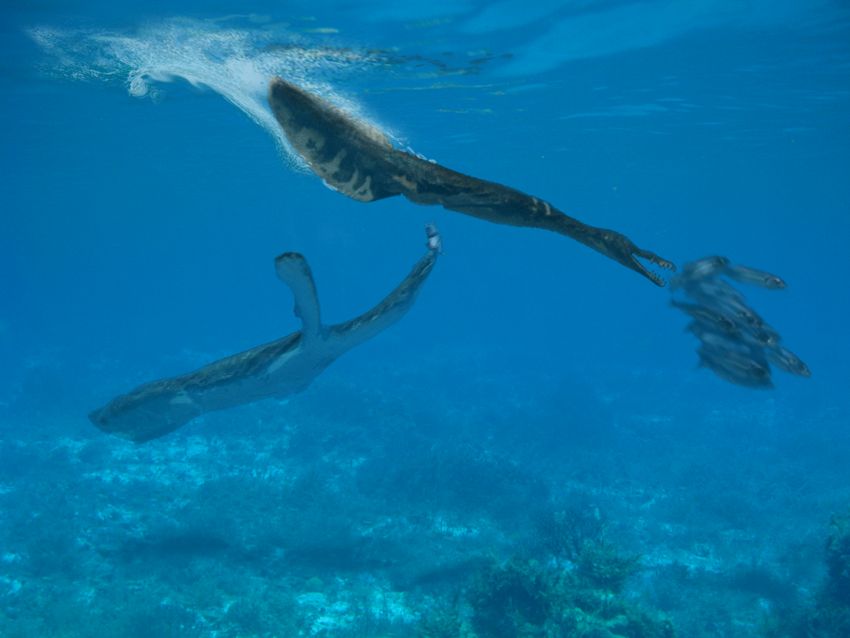
|
| Nothosaurus reconstruction made by Remie Bakker, a paleo-artist, in Rotterdam |
Winterswijk (also known as Winterswiek or Wenters) is a municipality and a
town in the eastern Netherlands.
It has a population of about 29,000 and is situated in the Achterhoek, which lies
in the eastern-most part of the province of Gelderland in the Netherlands.
Ankerpoort quarry in Winterswijk is important site where
good quality fossils of Triassic reptiles and their fauna are being unearthed.
In the Triassic period, the area of the quarry was the northern border of the
Palaeo-Tethys Ocean has been given the name "German basin".
The climate here was subtropical and the landscape was a hot, dry basin, like the Persian
Gulf today.
The weathering waste from the surrounding mountains was concentrated in this floodplain
as sand.
This is how the so called "Buntsandstein" came into being: an extremely thick layer of mostly hard,
red, colourful sandstone.
In 2009, a new species from the Winterswijk quarry was described: Nothosaurus winkelhorsti. This was a very small type of Nothosaur that roamed the sea at the same time as its big brother.
Another Nothosaur that looks like Nothosaurus was also found in Winterswijk, named Cymatosaurus. This is a saurian, which highly resembles the Nothosaur, but it belongs to a different group: the Pistosaurs.
These bones are in collections of two Museums in the Netherlands: Naturalis in Leiden and Twentse Welle Museum in Enschede.
Twentse Welle museum in Enschede opened doors in April 2008 and it is housed in a former textile factory. A mix of the original structure and new architecture give the museum its unique atmosphere. Three organizations are brought together in the museum: Van Deinse Instituut, Museum Jannink and Natuurmuseum (Natural History Museum) Enschede. Together they want to tell the story of the human adventure, the history of nature and exploration of earth, with the focus on the local history.
In 2011 Twentse Welle Museum in Enschede, acquired the large and important private collection of Gerben Diepenbroek, a true treasure trove of fossils from the Winterswijk quarries, including four Nothosaur skulls of which three are sufficiently complete to allow scientific description.The research of these skulls was published by Dr. Paul Cornelis Hendrikus Albers from the Naturalis Museum, later in the same year.
Thousands of fossil remains of the marine reptile Nothosaurus marchicus have been found in the quarries at Winterswijk, which enabled making the models resemble reality closely.
Complete articulated specimens are not known from the Winterswijk quarry, to date. However, in China and Switzerland, articulated specimens have been found. Unfortunately, these are not the same species, but the body plans are approximately the same.
Remie Bakker, from Manimal Works in Rotterdam, was asked to prepare two models, of a male and a female from the most abundant Nothosaurus specimens in the Netherlands: Nothosaurus marchicus. With the assistance of several scientists in the Netherlands and Germany, looking at other reconstructions in Stuttgart and Ingelfingen (Germany), and a dead monitor lizard, he prepared the fascinating models. Bakker's made a reconstruction completely different from the image created by the Czech artist Zdenek Burian in the 1960s. One of the models was depicted on the stamps.
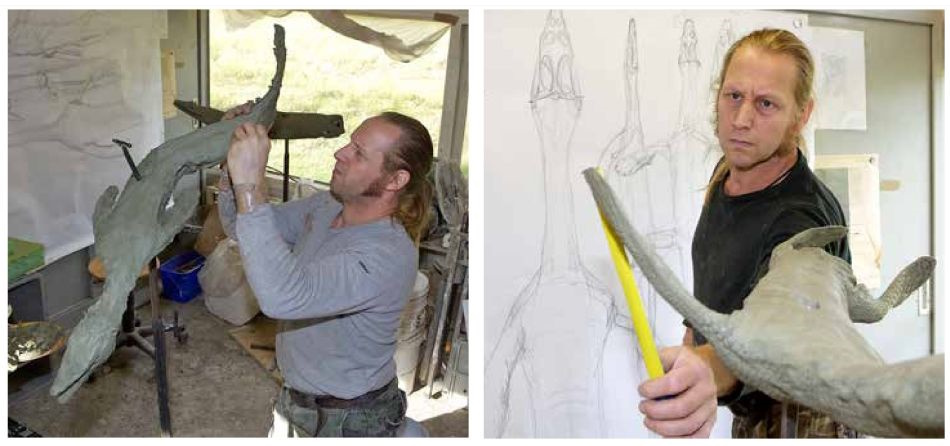
Products and associated philatelic items
| Examples of Circulated Covers | ||
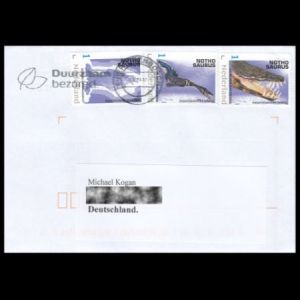 |
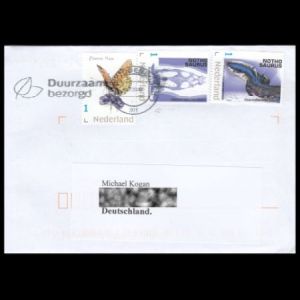 |
|
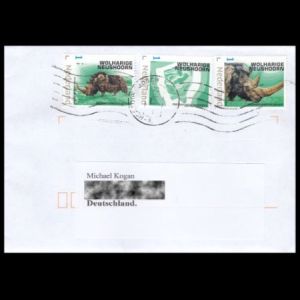 |
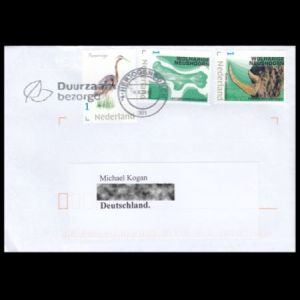 |
|
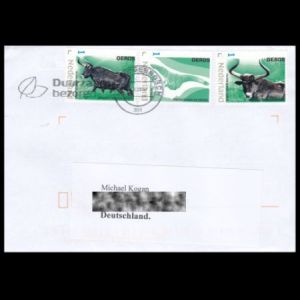 |
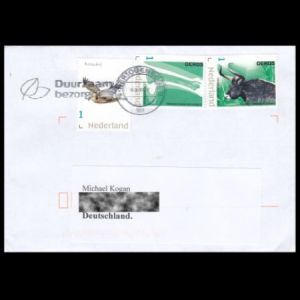 |
|
References
- Technical details: PostNL: [1], [2], [3]; WOPAplus.
- Manimal Works agency of Remie Bakker: official website,
- Dick Mol: Wikipedia,
- Twentse Welle Museum in Enschede: official website, Visit Enschede.
- Woolly rhinoceros Coelodonta: Wikipedia [1], [2]; Encyclopedia Britannica, rhinoresourcecenter.
- Aurochs, Bos primigenius: Wikipedia, Encyclopedia Britannica,
- Nothosaurus:
- Encyclopedia Britannica
- Wikipedia
- Dinosaur Fact
- Geologie Magazine Nr. 85
- "Nothosaurus marchicus: a reconstruction of a Sauropterygian from Winterswiek, the Netherlands", by Dennis C. Nieweg and Dick Mol
- Albers, P. (2011). New Nothosaurus skulls from the Lower Muschelkalk of the western Lower Saxony Basin (Winterswijk, the Netherlands) shed new light on the status of Nothosaurus winterswijkensis. Netherlands Journal of Geosciences, 90(1), 15-22.
- doi:10.1017/S0016774600000639.
- Sauropterygia: Wikipedia,
Acknowledgements

|
- Many thanks to Dr. Peter Voice from Department of Geological and Environmental Sciences, Western Michigan University, for reviewing the draft page and his very valuable comments.
- Many thanks to Mr. Dick Mol, a Dutch paleontologist for his help finding information about the animals depicted on these stamps, for his help finding an information about the animals and permission to use some photos from his article.
- Many thanks to Mr. Remie Bakker, for his permission to use images of his models and sharing some images which were not published on his website at the time the article was written.
- Many thanks to fellow collector Dr. Jos van den Bosch, from the Netherlands, for his help finding information about these stamps.
- Many thanks to fellow collector Dr. Peter Brandhuber, from Germany, who created the "The postal offices of Doggerland" map.
| <prev | back to index | next> |
